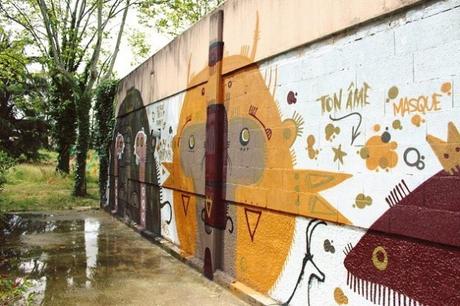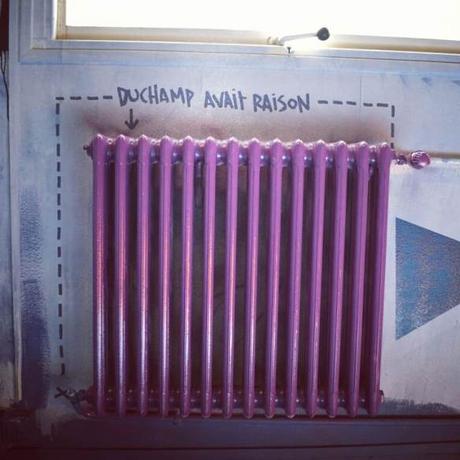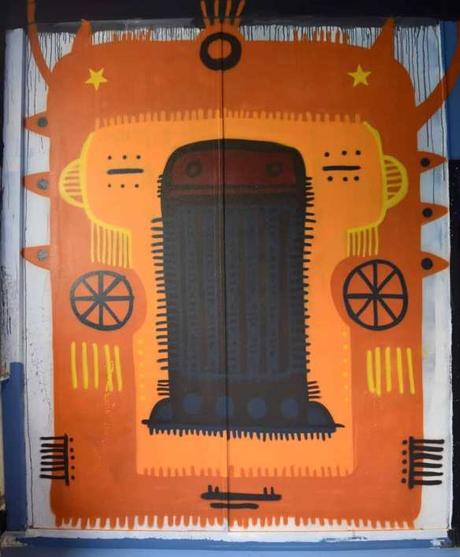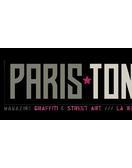J’ai été interviewé par Sunsun Hu (巴黎We Need Art中文版) lors de l’exposition From Gotham #2 à Saint-Ouen. Voici le texte en mandarin et sa traduction en anglais.

Tarek,漫畫作家,街頭藝術家,攝影師和旅行達人,
我們對他進行了採訪,大家一起來聽聽他的面具和小怪獸背後的故事吧!
TAREK於1971年出生於巴黎。 19歲時,他出版了一本名為« PARIS-TONKAR »的塗鴉參考書,講述了1987至1991年間巴黎及其近郊的街頭塗鴉運動。此書當時在專業人士中轟動一時,並影響了幾代塗鴉人。
多才多藝的藝術家TAREK首先是一位專業的動畫製片人。同時,他也是一位攝影師。 2010年起,他兼任« PARIS-TONKAR »雜誌的主編-他當年所著的參考書至今已成為塗鴉界膾炙人口的雜誌。這本雜誌致力於巴黎八十至九十年代的城市藝術和街頭塗鴉運動,也有一部分篇幅介紹外省的塗鴉世界。
他的靈感有時來自日常生活中偶然的遇見,無論是一場簡簡單單的在巴黎街頭或在居住地雷恩的漫步,或是充滿異國風情的環球旅行。
TAREK常常出現在法國乃至世界級別的藝術活動中,向觀眾展示他繪製的“部落面具”,波普藝術圖像,他所稱為“工作中的男人”或“城市中的女人”的作品,骷髏頭主題的畫作,或巧妙的對這些主題的混合,都令觀眾反思我們的社會。
他也常常參加一些城市藝術節,以讓街頭塗鴉藝術成為一種人人可參與的藝術形式,比如他也讓兒童加入到現場塗鴉創作表演的活動中來,因為對他而言,塗鴉運動能夠通過兒童,更加深入人心。

Tarek講到,他的作品被世界各地的人們收藏時,
我問他,那外國的買家會在你的作品中
看見法國文化或者巴黎氣息在你的作品中產生的影響嗎?
他說,不會,我的作品不僅僅有法國的文化,
他們來自我去過的所有地方的文化,
有南美,拉丁美洲,北美,非洲,亞洲,中東等地的文化元素,
很多作品都是這些文化的綜合,
「我也畫過中國的美猴王喔!」他驕傲地講。
他告訴我,他的觀眾們不知道Tarek到底是誰,
來自哪個國家和文化背景,
長什麼樣子,
即使他的媽媽,也不知道Tarek就是他。
他說,作為公眾人物,
我更希望把自己保護起來,
大家只看到我的作品就好了。

Tarek, comic writer, street artist, photographer and traveler.
Before the wall painting of the gallery’s backyard, he firstly removed the planted plants with a shovel and then pulled out the grass. It seems to be a ceremony, to remove some absurdity and create new life.
Seeing his process of creating a mask image is like a well-intentioned uncle who uses soft love to create a mischievous little creature. He is very talkative, humorous and cheerful, carefully painting every freckle on the face of the “mask”. He usually uses orange, khaki, dark blue as the background, and then draws details in other opposing colors.
He said that when he was 14 years old, he saw some street artworks near his home, and he was quite attracted. During the trip to London in the same year, he encountered the graffiti on subways. After returning home, he found an inkjet paint can in an abandoned warehouse and started the original graffiti creation with his friends. He said that the paint can should be used to paint the car, which is very hard to use for artistic creation, but the experience of the four teenagers sharing only one paint can has created a unique foundation for his career.
He graduated from the Art History Department of Sorbonne University Paris-1 and said that he had been orthodox for many years, but he felt that the knowledge from the school professors has not really helped him in his graffiti creation career. However, the knowledge of art history played an important role in the creation of his comics, and his comics promoted his graffiti creation. He said that in the end everything is connected, and our life experiences will eventually be linked, although not necessarily in the logical order we expected. Moreover, he also expressed that the basic skills of art he learned at school also helped him a lot in his future work. « No matter what you paint, basic skills are very important. The audience can see the quality of the work at a glance. » He said.
The children audience has a very important position in his creation, because he likes children, and more than half of his comic works are mainly targeted at children readers. He also has children himself, and his children are proud of their father and love painting. He said that the cultivation of art begins with children because they are the future of our world.
In the process of creation, will he consider how the audience is going to evaluate his artworks, or will he freely express what he wants to express? He said that in the process of artistic creation, we can’t think from the perspective of others, and we must let the works be completely inspirational and free expressions. Just like in our life, if everyone can’t be himself, considering the feelings and evaluations of others, then no one is the real one, so that everyone is behind the mask.
When asked: Are you behind the mask you painted? He said, haha, I’m behind every mask I paint, I look at my audience through the eyes of these masks. You see, when you look at these masks, their eyes are also staring at you!
Tarek said that when he was facing adults, he wanted to protect himself with a mask because he didn’t know if the people behind the mask were kind or evil. He likes to travel alone, and most of the travel trails he travels are alone, such as a trip across Canada. He said that there are many « others » in our life that make us tired, so that we can’t do what we want to do is we always regard them as too important. When faced with children, he can take off his mask and become a real himself.
“When I first saw your works, I thought you were creating little monsters. But today I know that you call them masks, so I think you need masks from the bottom of your heart.” I said. He answered: “Exactly! The works that are made for adults are usually masks, and my creations for children are mostly small monsters.”
As his works are collected by people all over the world, I asked him, “Would foreign buyers see the influence of French culture or Parisian influence on your works?” He said: “No, my works show not only French culture, my inspirations come from all the culture environment I’ve been to, in my works, you can find cultural elements from South America, Latin America, North America, Africa, Asia, Middle East, etc. Many works are the synthesis of several of these cultures. « I also painted the Chinese Monkey King! » he told me proudly. His audience does not know who Tarek is, from which country or cultural background, and what he looks like, even his mother does not know that Tarek is just him. As a public figure, he would like to protect himself. “The point is to see my work.” He said.


